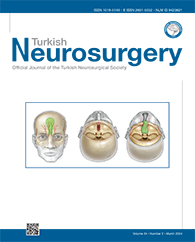2Capital Medical University, Beijing Neurosurgical Institute, Beijing, China DOI : 10.5137/1019-5149.JTN.42740-22.2 AIM: To evaluate and compare postoperative ischemic complications to determine the risk factors for ischemic complications following revascularization surgery for Moyamoya disease (MMD).
MATERIAL and METHODS: This single-center retrospective study included 266 procedures between 2016 and 2021. Three types of revascularization approaches including direct bypass, indirect bypass, and combined bypass were performed. To identify risk factors for postoperative ischemic complications and contralateral cerebral infarction, preoperative clinical characteristics and radiographic features were examined using multivariate and ordinal logistic regression analyses.
RESULTS: Postoperative ischemic complications occurred in 103 (6.6%) procedures. Ischemic presentation (p=0.001, odds ratios [OR] 5.59, 95% confidence interval [CI] 2.05?15.23), hypertension (p=0.030, OR 2.75, 95%CI 1.11? 6.83), advanced Suzuki stage (p=0.006, OR 3.19, 95%CI 1.40?7.26), and collateral circulation (p=0.001 OR 0.17, 95%CI 0.06?0.47) were risk factors for postoperative ischemic complications. Ordinal regression analysis revealed that unilateral involvement (p=0.043, OR 2.70, 95%CI 0.09?5.31), hemorrhagic presentation (p=0.013, OR 3.45, 95%CI 0.72?6.18), surgical approach (p=0.032, OR ?1.38, 95%CI ?2.65, ?0.12), and collateral circulation [p=0.043, OR ?1 .27, 95%CI ?2.51, ?0.04)] were associated with the type of ischemic complications. History of hypertension (p=0.031) and contralateral computed tomography (CT) perfusion stage (p=0.045) were associated with contralateral infarction.
CONCLUSION: Inability of cerebral vessels to withstand changes in blood pressure induced by revascularization-related hemodynamic instability might be associated with postoperative complications in patients with Moyamoya disease.
Keywords : Collateral circulation, Hypertension, Infarction, Moyamoya disease




